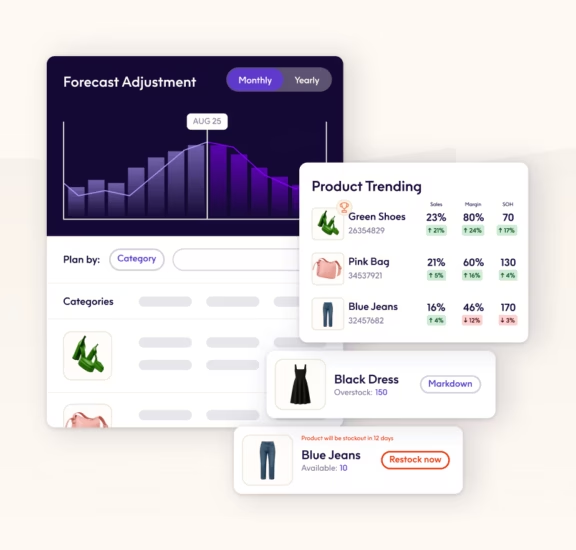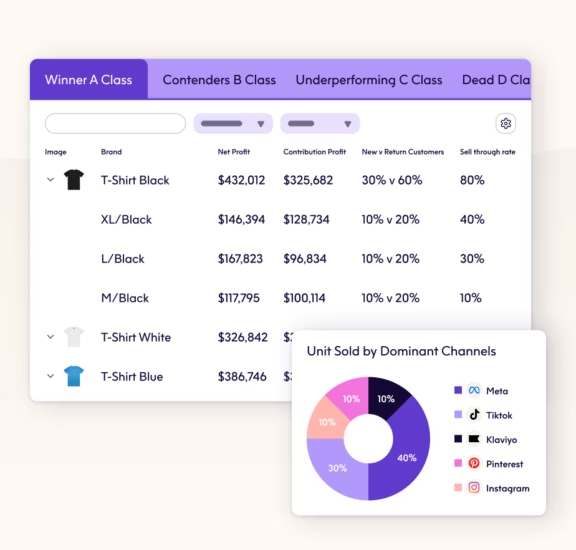In Conversation With: Carla Penn of ProfitPeak Tom sits down with ProfitPeak Co-Founder and CEO, Carla Penn to learn about one of the fastest growing E-commerce tech platforms, growing profitability, and the balance between commercial and creative.

ProfitPeak was born from the lived experiences of serial entrepreneurs in the retail industry. The founders, Carla and David, spent years acquiring, bootstrapping, and successfully exiting multiple e-commerce businesses. As they scaled, they faced rising acquisition costs, shrinking margins, and declining profits, without understanding the root cause. To cut through the fog, they built an in-house operating system that provided real-time insights into profitability across customers, orders, inventory, and advertising.
They have successfully launched the product over the last 2 years, and are quickly growing a raving list of customers. With big growth ambitions, Tom sits down with Carla to talk shop.
Tell me about Profit Peak. How did it come about, what problem does it solve for growing brands?
I founded ProfitPeak in 2022 with my husband David Kahn. It was built inside our own ecommerce business and built to solve our biggest challenges. These challenges are what all ecommerce businesses face - fragmented, siloed data across sales, marketing, inventory and operations. A lot of data, not a lot of insights or confident action.
ProfitPeak is a single source of truth and ties advertising performance directly to inventory levels, inventory forecasting and company profitability. We clear the fog, giving brands clarity and confidence to scale advertising, customer and inventory investment for growth.
Profit Peak is starting to grow rapidly, and we have seen first-hand, how having more retail data easily available for all facets of a business can help a brand increase revenue and profit. What do you see as the biggest opportunity for brands using Profit Peak?
The biggest opportunity for brands using ProfitPeak is the shift from reactive to proactive decision-making. Most growing brands spend too much time piecing together disconnected reports, chasing lagging indicators, or relying on gut feel when allocating budgets, setting pricing, or planning inventory.
With ProfitPeak, brands gain real-time, profit-first visibility across their entire retail and marketing ecosystem, meaning they can anticipate challenges before they hit—whether that’s pausing ad spend on low-stock SKUs, doubling down on high-margin products, or spotting early signs of customer behaviour shifts.
True data-driven decision-making goes beyond static reports—it’s about being able to ask questions, uncover insights, and act on them quickly. In today’s AI-first world, brands want clarity, efficiency, and confidence in their decisions. With ProfitPeak, teams can explore their data using natural language, spot opportunities and risks earlier, and receive actionable recommendations that directly fuel revenue growth and protect profit.
How does the Profit Peak platform work to inform both information for Performance Marketing Agencies, as well as information for brands who outsource the performance side of their marketing? How can brands leverage that data to inform wider business and marketing decisions?
The ProfitPeak platform acts as a single source of truth, aligning both performance marketing agencies and brand operators around profit, not just revenue. For agencies, it delivers real-time visibility into ad performance tied directly to product margins, inventory levels, and fulfilment costs, so spend can be optimised for true ROI rather than vanity metrics.
This means agencies can immediately see which SKUs to scale, which to pause, and where budgets will drive the most profitable outcomes. For brands outsourcing their performance marketing, ProfitPeak empowers internal teams to validate agency decisions, understand the “why” behind spend allocations.
Beyond marketing, centralising this data allows brands to make wider commercial decisions with confidence. Merchandising teams can align promotions with healthy stock positions, pricing teams can see the real impact of discounts on profit, and leadership can track live profitability by SKU, channel, or region. It also enables brands to identify their highest-value customers, ensuring marketing efforts attract buyers who deliver sustainable revenue and long-term growth. In short, agencies gain sharper levers to optimise campaigns, while brands gain clarity to grow smarter and more profitably across the whole business.
A continuous challenge for our clients in the growth phase is maintaining profitability whilst still investing for growth, what are the key 3 things brands should be doing to ensure they are building a sustainable business?
There are three key things I focused on and every brand should at any stage:
- Profit-First Decision Making – Don’t just track revenue growth; measure profit at every level of the business. This ensures marketing and operational investments are judged on contribution to the bottom line, not vanity metrics.
- Aligning Marketing with Inventory & Margins – Growth can erode quickly if you’re driving traffic to low-margin or low-stock products. Brands should tightly connect performance marketing to real-time inventory and margin data to scale the right SKUs and avoid discounting into losses.
- Managing Cash Conversion Cycles – Growth eats cash, and many brands stumble here. Keeping a tight handle on cash conversion cycles—ensuring stock turns quickly, negotiating favourable supplier terms, and avoiding over-investment in slow-moving inventory. This discipline creates the headroom to invest confidently in future growth opportunities.

Forecasting is often very challenging for brands, with macro economic trends, as well as the retail calendar and seasonal changes for most of our clients. How do you think brands can better forecast DTC sales?
We have to recognise forecasts are a guide only. We can improve accuracy by segmenting new versus returning customers, as repeat buyers are more predictable while new acquisition depends on marketing performance and seasonal drops. Layering in seasonal trends and discounting periods—like sitewide sales or promotional events—helps anticipate spikes and dips. By combining customer behaviour, seasonality, and margin impact, brands can create dynamic, realistic forecasts that protect profit while planning for growth.
When we start working with a new client, we often find that they have subtly been on sale or offered mid-season discounts far more regularly than they think, how does Profit Peak support better inventory management, better planning and less discounting?
ProfitPeak helps break that cycle by:
- Inventory intelligence: We connect sales, inventory, and channel data so you have a clear picture of what’s moving, what’s overstocked, and what’s genuinely at risk of ageing.
- Planning with foresight: Our forecasting models highlight when to reorder, when to slow down, and when to reserve stock for higher-margin channels. That reduces the panic-driven discounting that often happens late in season.
- Profit-first lens: Instead of blanket markdowns, we help brands segment where discounts are needed versus where margin can be protected — using bundles, targeted offers, or channel-specific strategies.
The result is fewer unnecessary sales, stronger margins, and healthier inventory positions going into peak trading periods.
Speaking of discounting, Q4 / BFCM is here. How can brands prepare for the final quarter to grow profitably?
At ProfitPeak, we’ve prepared a strategy document for all our clients. We analysed Q4 2024 performance and used it to build a playbook that answers the key questions for this year:
- When to start acquiring new customers to have them primed before peak sale periods.
- Which marketing channels delivered the most traffic and the highest ROI, so spend can be allocated with confidence.
- Which products are best at bringing in new customers vs re-activating existing ones.
- When to re-target customers post-sale to drive the most customer lifetime value instead of just chasing one-off orders.
That preparation means our clients head into Q4 with a clear roadmap: not just to win revenue, but to win profitably.

Profit Peak predominantly focuses on Medium-sized businesses. What can small businesses (doing around or just under 7 figures in DTC revenue) do now to improve their businesses prior to engaging Profit Peak?
Tracking profit rather than just revenue is a great place to start, tightening inventory management to avoid unnecessary discounting, focusing on nurturing your best customers, and being intentional with paid spend by doubling down on the channels that truly deliver. Nail these fundamentals, and you’ll not only see better results now, but also be in a much stronger position to scale.
What are 3 things brands should focus on to improve their profit margins?
Improving profit margins can be simplified when you apply the 80/20 rule — the idea that a small percentage drives the majority of results. First, ads: usually 20% of campaigns drive 80% of profitable returns, so double down on what works and cut wasted spend quickly. Second, customers: the top 20% of customers often generate the bulk of profit, so nurture them with retention strategies and avoid overspending to chase low-value buyers. Third, products: not every SKU is equal, focus on the 20% of products that deliver the highest margins and use smart merchandising to avoid over-investing in low-profit or slow-moving stock.
What are you most looking forward to in the coming months?
What I am most looking forward to in the coming months is witnessing profitable trade through the “Super Bowl” of retail, November. For most brands, Q4 is the period that makes or breaks the year, and I really hope it’s successful for all the founders and teams out there.






